






An ingrown toenail occurs when the edge of the toenail grows into the surrounding skin, causing pain, swelling, and redness. This condition most commonly affects the big toe but can occur on any toe. The main causes of ingrown toenails include improper nail trimming, where the nails are cut too short or rounded at the edges, and wearing tight or ill-fitting shoes that put pressure on the toes. Injuries to the toe, such as stubbing, can also lead to an ingrown toenail. Prevention involves trimming toenails straight across to avoid sharp edges that can dig into the skin. Wearing shoes that fit properly and allow for adequate toe room is also essential. Keeping the feet clean and dry, and avoiding excessive pressure on the toes, can further help prevent ingrown toenails and reduce the risk of infection. If you have an ingrown toenail, it is strongly suggested that you promptly contact a podiatrist who can offer you appropriate treatment solutions.
Ingrown toenails may initially present themselves as a minor discomfort, but they may progress into an infection in the skin without proper treatment. For more information about ingrown toenails, contact one of our podiatrists of Active Foot and Ankle Care, LLC. Our doctors can provide the care you need to keep you pain-free and on your feet.
Ingrown Toenails
Ingrown toenails are caused when the corner or side of a toenail grows into the soft flesh surrounding it. They often result in redness, swelling, pain, and in some cases, infection. This condition typically affects the big toe and may recur if it is not treated properly.
Causes
You are more likely to develop an ingrown toenail if you are obese, have diabetes, arthritis, or have any fungal infection in your nails. Additionally, people who have foot or toe deformities are at a higher risk of developing an ingrown toenail.
Symptoms
Some symptoms of ingrown toenails are redness, swelling, and pain. In rare cases, there may be a yellowish drainage coming from the nail.
Treatment
Ignoring an ingrown toenail can have serious complications. Infections of the nail border can progress to a deeper soft-tissue infection, which can then turn into a bone infection. You should always speak with your podiatrist if you suspect you have an ingrown toenail, especially if you have diabetes or poor circulation.
If you have any questions, please feel free to contact our offices located in Fair Lawn, Riverdale, and Englewood, NJ . We offer the newest diagnostic and treatment technologies for all your foot care needs.

A podiatrist is a medical professional specializing in the diagnosis, treatment, and prevention of foot and ankle conditions. They treat a wide range of foot issues, from common ailments to more complex conditions. Gait analysis is one important service provided, where the podiatrist observes a patient’s walking pattern to identify abnormalities or issues that may cause pain or lead to injury. Podiatrists also perform procedures such as partial nail avulsion, a technique used to remove a portion of a toenail to treat painful ingrown nails. For warts or verrucas on the feet, swift verruca treatment is a popular option, using microwave technology to target and treat the infection. Additionally, podiatrists help manage conditions like flat feet and heel pain, offering solutions such as custom orthotics, stretching exercises, or lifestyle changes to improve foot health and alleviate discomfort. If you have any type of foot pain, it is suggested that you consult a podiatrist who can effectively treat various foot conditions.
If you are dealing with pain in your feet and ankles, you may want to seek help from a podiatrist. Feel free to contact one of our podiatrists from Active Foot and Ankle Care, LLC. Our doctors can provide the care you need to keep you pain-free and on your feet.
What Is a Podiatrist?
A podiatrist is a doctor of podiatric medicine who diagnoses and treats conditions of the foot, ankle, and related structures of the leg. Your podiatrist may specialize in a certain field such as sports medicine, wound care, pediatrics, and diabetic care. Podiatrists have the ability to become board certified through training, clinical experience, and then taking an exam.
What Do Podiatrists Do?
On a daily basis, a podiatrist may perform the following activities:
It is very important that you take care of your feet. It’s easy to take having healthy feet for granted, however foot problems tend to be among the most common health conditions. Podiatrists can help diagnose and treat a variety of feet related conditions, so it is crucial that you visit one if you need assistance.
If you have any questions please feel free to contact our offices located in Fair Lawn, Riverdale, and Englewood, NJ . We offer the newest diagnostic and treatment technologies for all your foot and ankle needs.
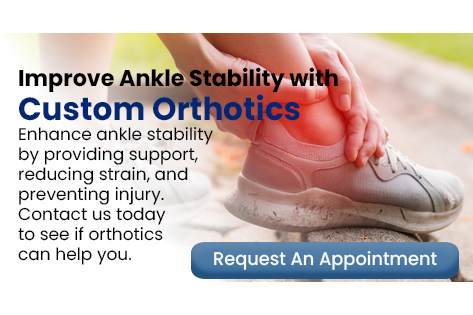
Step with assurance, thanks to enhanced ankle stability from orthotics! If you're active and on the move, Custom Orthotics are your ally for stronger, steadier ankles. They align your foot and ankle, reducing the risk of sprains and offering solid support for every stride. Don’t let instability hold you back. Try Custom Orthotics from our office, and discover unshakable confidence in every step!

As people age, they often experience a variety of foot problems that can significantly impact their mobility and quality of life. Plantar fasciitis is a common issue among seniors that is characterized by heel pain due to inflammation of the plantar fascia. Bunions, or painful bony bumps at the base of the big toe, can develop from years of wearing ill-fitting shoes. Corns, which are thickened areas of skin caused by friction, also frequently affect seniors. Osteoarthritis can lead to joint pain and stiffness in the feet, affecting mobility. Additionally, Achilles tendinitis, an inflammation of the Achilles tendon, can cause discomfort at the back of the heel. Addressing these conditions early through wearing proper footwear, doing targeted stretching exercises, and medical intervention can help seniors maintain their independence and enjoy a more active lifestyle.If you are elderly and have foot pain, it is suggested that you consult a podiatrist who can treat various foot conditions, in addition to monitoring your foot health.
Proper foot care is something many older adults forget to consider. If you have any concerns about your feet and ankles, contact one of our podiatrists from Active Foot and Ankle Care, LLC. Our doctors can provide the care you need to keep you pain-free and on your feet.
The Elderly and Their Feet
As we age we start to notice many changes in our body, but the elder population may not notice them right away. Medical conditions may prevent the elderly to take notice of their foot health right away. Poor vision is a lead contributor to not taking action for the elderly.
Common Conditions
Susceptible Infections
Diabetes and poor circulation can cause general loss of sensitivity over the years, turning a simple cut into a serious issue.
If you have any questions please feel free to contact our offices located in Fair Lawn, Riverdale, and Englewood, NJ . We offer the newest diagnostic and treatment technologies for all your foot and ankle needs.
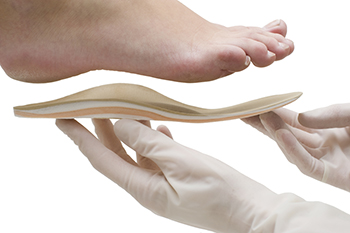
Custom orthotics are particularly beneficial for managing foot pain, especially in individuals with diabetes. Diabetic patients often face unique foot challenges, such as poor circulation and neuropathy, which increase the risk of ulcers and injuries. Custom orthotics can provide tailored support, alleviating pressure on sensitive areas, improving circulation, and preventing further complications. Unlike over-the-counter, or OTC orthotics, custom orthotics are designed to address the specific needs of each individual. OTC options may offer some relief but lack the precise fit and customization necessary for correcting underlying biomechanical issues. Custom orthotics can realign the foot, correcting imbalances and distributing weight more evenly, thus reducing pain and improving function. By targeting the root cause of the pain, custom orthotics offer a more effective long-term solution, helping diabetic patients manage discomfort and prevent further complications, while OTC orthotics may fall short for more complex needs. If you have diabetic foot problems or other complex foot issues, it is suggested that you visit a podiatrist for an examination and input on how custom orthotics might be able to help you.
If you’re experiencing foot discomfort, have a history of foot and ankle injuries, or are interested in exploring Custom orthotics, don’t hesitate to contact one of our podiatrists at Active Foot and Ankle Care, LLC. Our doctors is dedicated to offering the care required to help you remain pain-free and stay on your feet.
What are Custom Orthotics?
Custom orthotics refer to custom inserts designed for placement in different shoe types, including athletic and formal footwear, with the purpose of alleviating a spectrum of foot-related problems such as flat feet, heel pain, and overall foot discomfort. These inserts are instrumental in providing relief and comfort for a diverse range of foot conditions, including heel pain, and can also act as a proactive approach to injury prevention.
Medical Grade Shoe Inserts:
A diverse array of shoe inserts is available for addressing foot pain, heel discomfort, and minor issues. For instance, you can place arch supports in your shoes to rectify overarched or flat feet, and gel and cushioned insoles are frequently chosen for the comfort and relief they provide from foot and heel pain by reducing pressure.
If you have any questions please contact our offices located in Fair Lawn, Riverdale, and Englewood, NJ . We offer the newest diagnostic and treatment technologies for all your foot and ankle needs.
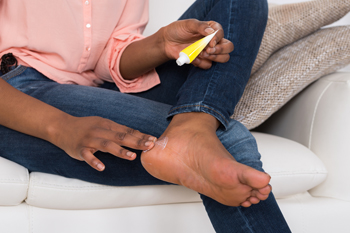
Cracked heels are a common issue that can lead to discomfort, pain, and in severe cases, infection. Cracked heels develop when thickened skin on the heels, called calluses, becomes dry and splits open due to pressure from walking or standing. This is particularly common in people with diabetes or circulation issues, like peripheral artery disease. Callused skin first develops as a protective response to friction and pressure, but it can crack if it becomes too dry. The subsequent heel fissures can cause discomfort, make walking difficult and increase the chances of infection. A podiatrist can help by carefully debriding thickened calluses to reduce pressure and advising on proper foot care and moisturizing techniques. This foot doctor can also determine if you have any underlying issues that may need medical attention. Such a proactive approach can help reduce the risk of complications and promote foot health. If you have problematic cracked heels, it is suggested that you schedule an appointment with a podiatrist for an exam and treatment.
Cracked heels are unsightly and can cause further damage to your shoes and feet. If you have any concerns, contact one of our podiatrists from Active Foot and Ankle Care, LLC. Our doctors can provide the care you need to keep you pain-free and on your feet.
Cracked Heels
Cracked heels appear unappealing and can make it harder for you walk around in sandals. Aside from looking unpleasant, cracked heels can also tear stockings, socks, and wear out your shoes. There are several methods to help restore a cracked heel and prevent further damage.
How Do You Get Them?
Dry skin is the number one culprit in creating cracked heels. Many athletes, walkers, joggers, and even swimmers suffer from cracked heels. Age and skin oil production play a role to getting cracked heels as well.
Promote Healing
Over the counter medicines can help, especially for those that need instant relief or who suffer from chronic dry feet.
Wear Socks – Wearing socks with medicated creams helps lock in moisture.
Moisturizers – Applying both day and night will help alleviate dryness which causes cracking.
Pumice Stones – These exfoliate and remove dead skin, which allows for smoother moisturizer application and better absorption into the skin.
Change in Diet
Eating healthy with a well-balanced diet will give the skin a fresh and radiant look. Your body responds to the kinds of food you ingest. Omega-3 fatty acids and zinc supplements can also revitalize skin tissue.
Most importantly, seek professional help if unsure how to proceed in treating cracked heels. A podiatrist will help you with any questions or information needed.
If you have any questions, please feel free to contact our offices located in Fair Lawn, Riverdale, and Englewood, NJ . We offer the newest diagnostic and treatment technologies for all your foot care needs.
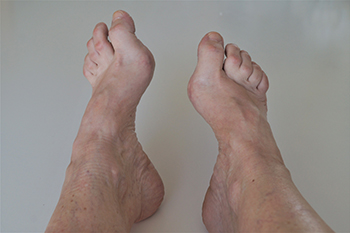
High arches, also known as cavus foot, can lead to various foot problems due to the uneven distribution of weight. People with high arches often experience pain on the outside of the foot, ankle instability, and discomfort under the ball of the foot, particularly beneath the first metatarsal. The high arch foot structure puts excessive pressure on certain areas, which can increase the risk of issues like plantar fasciitis. Instability in the ankle can cause people to feel like they are tipping outward, which may lead to lateral foot pain or stress fractures. Diagnosing high arches involves evaluating muscle strength, assessing pain patterns, and using imaging tests, if necessary. A podiatrist can prescribe custom orthotics to support the foot’s structure and relieve pressure points. In severe cases, surgery may be needed to correct deformities or address any underlying issues. If you have high arches and are eperiencing foot problems, it is suggested that you schedule an appointment with a podiatrist for an evaluation and treatment.
If you have any concerns about your feet, contact one of our podiatrists from Active Foot and Ankle Care, LLC. Our doctors can provide the care you need to keep you pain-free and on your feet.
Biomechanics in Podiatry
Podiatric biomechanics is a particular sector of specialty podiatry with licensed practitioners who are trained to diagnose and treat conditions affecting the foot, ankle and lower leg. Biomechanics deals with the forces that act against the body, causing an interference with the biological structures. It focuses on the movement of the ankle, the foot and the forces that interact with them.
A History of Biomechanics
Modern technological improvements are based on past theories and therapeutic processes that provide a better understanding of podiatric concepts for biomechanics. Computers can provide accurate information about the forces and patterns of the feet and lower legs.
Understanding biomechanics of the feet can help improve and eliminate pain, stopping further stress to the foot.
If you have any questions please feel free to contact our offices located in Fair Lawn, Riverdale, and Englewood, NJ . We offer the newest diagnostic and treatment technologies for all your foot and ankle needs.
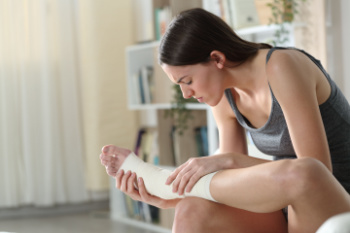
Foot stress fractures are hairline cracks in the bones often caused by repetitive strain. Several risk factors can increase the likelihood of developing stress fractures, especially in the feet. People who participate in high-impact activities, such as running, dancing, or gymnastics, face a higher risk of stress fractures from the repeated pressure and pounding on their feet. Women, particularly those experiencing menstrual irregularities, may be more prone to fractures due to lower bone density. Conditions like osteoporosis or insufficient intake of vitamin D and calcium can further weaken bones and increase the risk. Foot structure issues, such as high arches or flat feet, can also lead to stress fractures, as well as wearing poor footwear or sudden changes in activity surfaces. Podiatrists play a key role in diagnosing and managing foot stress fractures. This foot doctor may use imaging techniques such as MRI scans to confirm the injury. If you have foot pain that may indicate a stress fracture, it is suggested that you schedule an appointment with a podiatrist for an exam and treatment.
Activities where too much pressure is put on the feet can cause stress fractures. To learn more, contact one of our podiatrists from Active Foot and Ankle Care, LLC. Our doctors can provide the care you need to keep your pain free and on your feet.
Dealing with Stress Fractures of the Foot and Ankle
Stress fractures occur in the foot and ankle when muscles in these areas weaken from too much or too little use. The feet and ankles then lose support when walking or running from the impact of the ground. Since there is no protection, the bones receive the full impact of each step. Stress on the feet can cause cracks to form in the bones, thus creating stress fractures.
What Are Stress Fractures?
Stress fractures occur frequently in individuals whose daily activities cause great impact on the feet and ankles. Stress factors are most common among:
Symptoms
Pain from the fractures occur in the area of the fractures and can be constant or intermittent. It will often cause sharp or dull pain with swelling and tenderness. Engaging in any kind of activity which involves high impact will aggravate pain.
If you have any questions please feel free to contact our offices located in Fair Lawn, Riverdale, and Englewood, NJ . We offer the newest diagnostic and treatment technologies for all your foot and ankle needs.
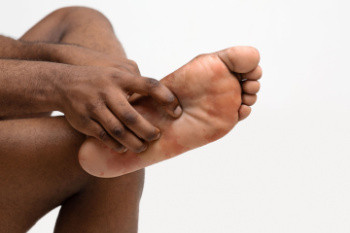
Plantar fasciitis is a frequent cause of heel pain that affects the thick band of tissue, known as the plantar fascia, which runs along the bottom of the foot. Pain is usually most noticeable during the first few steps after waking or after long periods of inactivity, but can also worsen with prolonged standing or walking. Discomfort occurs from microtears at the point where the plantar fascia connects to the heel bone, triggering inflammation. Risk factors for plantar fasciitis include excessive standing, increased body weight, aging, a sudden change in activity level, or tight calf muscles. A podiatrist can help by assessing your foot mechanics, recommending specific stretches for the calf and plantar fascia, and suggesting modifications in footwear and activity levels to reduce stress on the affected area. In most cases, non-surgical treatment is effective in relieving symptoms and improving function. If you have heel pain that may be caused by plantar fasciitis, it is suggested that you schedule an appointment with a podiatrist.
Plantar fasciitis is a common foot condition that is often caused by a strain injury. If you are experiencing heel pain or symptoms of plantar fasciitis, contact one of our podiatrists from Active Foot and Ankle Care, LLC. Our doctors can provide the care you need to keep you pain-free and on your feet.
What Is Plantar Fasciitis?
Plantar fasciitis is one of the most common causes of heel pain. The plantar fascia is a ligament that connects your heel to the front of your foot. When this ligament becomes inflamed, plantar fasciitis is the result. If you have plantar fasciitis you will have a stabbing pain that usually occurs with your first steps in the morning. As the day progresses and you walk around more, this pain will start to disappear, but it will return after long periods of standing or sitting.
What Causes Plantar Fasciitis?
There are some risk factors that may make you more likely to develop plantar fasciitis compared to others. The condition most commonly affects adults between the ages of 40 and 60. It also tends to affect people who are obese because the extra pounds result in extra stress being placed on the plantar fascia.
Prevention
There are a variety of treatment options available for plantar fasciitis along with the pain that accompanies it. Additionally, physical therapy is a very important component in the treatment process. It is important that you meet with your podiatrist to determine which treatment option is best for you.
If you have any questions, please feel free to contact our offices located in Fair Lawn, Riverdale, and Englewood, NJ . We offer the newest diagnostic and treatment technologies for all your foot care needs.
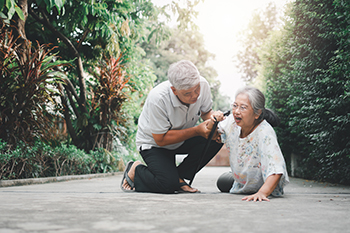
Falling outside the home can pose a significant risk, especially for older adults. Falls outside the home can be caused by uneven terrain, slippery surfaces, or crowded areas. Parks, parking lots, and public staircases are common spots where falls may occur, leading to serious injuries like broken bones. Footwear choices play a vital role in preventing falls. Your shoes should offer solid support, fit properly, and have non-slip soles to provide stability. Balance issues, lower extremity weakness, or joint pain can also increase the risk of falls outside the home. A podiatrist can assess these factors, recommend supportive footwear, and suggest custom orthotics to improve balance. This foot doctor can address underlying foot conditions that might compromise your stability or suggest exercises and assistive devices to improve balance. If you have injured your foot or ankle from falling, it is suggested that you schedule an appointment with a podiatrist for appropriate treatment methods.
Preventing falls among the elderly is very important. If you are older and have fallen or fear that you are prone to falling, consult with one of our podiatrists from Active Foot and Ankle Care, LLC. Our doctors will assess your condition and provide you with quality advice and care.
Every 11 seconds, an elderly American is being treated in an emergency room for a fall related injury. Falls are the leading cause of head and hip injuries for those 65 and older. Due to decreases in strength, balance, senses, and lack of awareness, elderly persons are very susceptible to falling. Thankfully, there are a number of things older persons can do to prevent falls.
How to Prevent Falls
Some effective methods that older persons can do to prevent falls include:
Falling can be a traumatic and embarrassing experience for elderly persons; this can make them less willing to leave the house, and less willing to talk to someone about their fears of falling. Doing such things, however, will increase the likelihood of tripping or losing one’s balance. Knowing the causes of falling and how to prevent them is the best way to mitigate the risk of serious injury.
If you have any questions, please feel free to contact our offices located in Fair Lawn, Riverdale, and Englewood, NJ . We offer the newest diagnostic and treatment technologies for all your foot care needs.
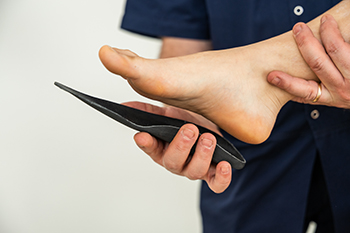
When treating plantar fasciitis, custom orthotics offer a personalized approach that targets the specific needs of the patient. They provide support to the arch and cushioning the heel to alleviate pain. Unlike over-the-counter inserts, custom orthotics are designed based on the individual’s foot structure and gait to ensure a more precise fit and long-term relief. Other treatments for plantar fasciitis include stretching exercises and anti-inflammatory medications. These methods focus on reducing inflammation and strengthening the muscles around the foot but may not address underlying biomechanical issues. In severe cases, corticosteroid injections or surgery may be recommended, though these options come with potential risks. Custom orthotics, by contrast, are non-invasive and aim to correct abnormal foot mechanics, often preventing the condition from worsening. It is suggested that you consult a podiatrist who can help to determine the best combination of treatments for effective pain relief and long-term recovery.
If you are experiencing discomfort in your feet and would like to try custom orthotics, contact one of our podiatrists from Active Foot and Ankle Care, LLC. Our doctors can provide the care you need to keep you pain-free and on your feet.
What Are Custom Orthotics?
Custom orthotics are inserts you can place into your shoes to help with a variety of foot problems such as flat feet or foot pain. Orthotics provide relief and comfort for minor foot and heel pain.
Over-the-Counter Inserts
Shoe inserts come in a wide variety and are used to treat foot pain, heel pain, and minor problems. For example, arch supports can be inserted into your shoes to help correct overarched or flat feet, while gel insoles are often used because they provide comfort and relief from foot and heel pain by alleviating pressure.
Prescription Orthotics
If over-the-counter inserts don’t work for you or if you have a more severe foot concern, it is possible to have your podiatrist prescribe custom orthotics. These high-quality, custom inserts are designed to treat problems such as abnormal motion, plantar fasciitis, and severe forms of heel pain. They can even be used to help patients suffering from diabetes by treating foot ulcers and painful calluses and are usually molded to your feet individually, which allows them to provide full support and comfort.
If you're experiencing minor to severe foot or heel pain, it’s recommended to speak with your podiatrist about the possibility of using custom orthotics or shoe inserts. A podiatrist can determine which type of custom orthotic or shoe insert is right for you and help you take the first steps toward being pain-free.
If you have any questions please contact our offices located in Fair Lawn, Riverdale, and Englewood, NJ . We offer the newest diagnostic and treatment technologies for all your foot and ankle needs.






